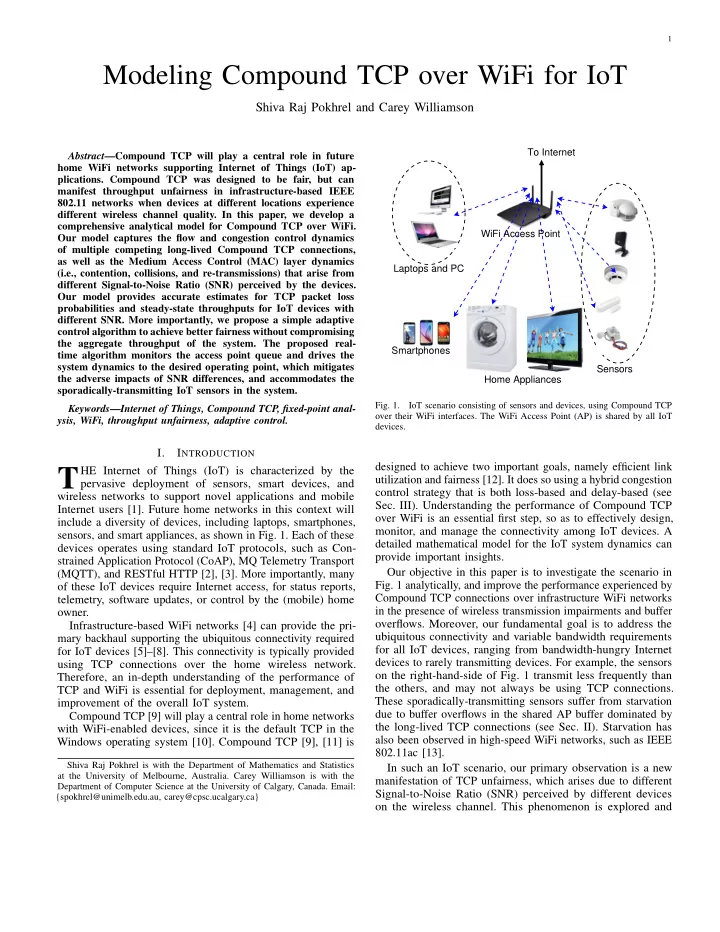

1 Modeling Compound TCP over WiFi for IoT Shiva Raj Pokhrel and Carey Williamson To Internet Abstract —Compound TCP will play a central role in future home WiFi networks supporting Internet of Things (IoT) ap- plications. Compound TCP was designed to be fair, but can manifest throughput unfairness in infrastructure-based IEEE 802.11 networks when devices at different locations experience different wireless channel quality. In this paper, we develop a comprehensive analytical model for Compound TCP over WiFi. WiFi Access Point Our model captures the flow and congestion control dynamics of multiple competing long-lived Compound TCP connections, as well as the Medium Access Control (MAC) layer dynamics Laptops and PC (i.e., contention, collisions, and re-transmissions) that arise from different Signal-to-Noise Ratio (SNR) perceived by the devices. Our model provides accurate estimates for TCP packet loss probabilities and steady-state throughputs for IoT devices with different SNR. More importantly, we propose a simple adaptive control algorithm to achieve better fairness without compromising the aggregate throughput of the system. The proposed real- Smartphones time algorithm monitors the access point queue and drives the Sensors system dynamics to the desired operating point, which mitigates Home Appliances the adverse impacts of SNR differences, and accommodates the sporadically-transmitting IoT sensors in the system. Fig. 1. IoT scenario consisting of sensors and devices, using Compound TCP Keywords — Internet of Things, Compound TCP, fixed-point anal- over their WiFi interfaces. The WiFi Access Point (AP) is shared by all IoT ysis, WiFi, throughput unfairness, adaptive control. devices. I. I NTRODUCTION designed to achieve two important goals, namely efficient link T HE Internet of Things (IoT) is characterized by the utilization and fairness [12]. It does so using a hybrid congestion pervasive deployment of sensors, smart devices, and control strategy that is both loss-based and delay-based (see wireless networks to support novel applications and mobile Sec. III). Understanding the performance of Compound TCP Internet users [1]. Future home networks in this context will over WiFi is an essential first step, so as to effectively design, include a diversity of devices, including laptops, smartphones, monitor, and manage the connectivity among IoT devices. A sensors, and smart appliances, as shown in Fig. 1. Each of these detailed mathematical model for the IoT system dynamics can devices operates using standard IoT protocols, such as Con- provide important insights. strained Application Protocol (CoAP), MQ Telemetry Transport Our objective in this paper is to investigate the scenario in (MQTT), and RESTful HTTP [2], [3]. More importantly, many Fig. 1 analytically, and improve the performance experienced by of these IoT devices require Internet access, for status reports, Compound TCP connections over infrastructure WiFi networks telemetry, software updates, or control by the (mobile) home in the presence of wireless transmission impairments and buffer owner. overflows. Moreover, our fundamental goal is to address the Infrastructure-based WiFi networks [4] can provide the pri- ubiquitous connectivity and variable bandwidth requirements mary backhaul supporting the ubiquitous connectivity required for all IoT devices, ranging from bandwidth-hungry Internet for IoT devices [5]–[8]. This connectivity is typically provided devices to rarely transmitting devices. For example, the sensors using TCP connections over the home wireless network. on the right-hand-side of Fig. 1 transmit less frequently than Therefore, an in-depth understanding of the performance of the others, and may not always be using TCP connections. TCP and WiFi is essential for deployment, management, and These sporadically-transmitting sensors suffer from starvation improvement of the overall IoT system. due to buffer overflows in the shared AP buffer dominated by Compound TCP [9] will play a central role in home networks the long-lived TCP connections (see Sec. II). Starvation has with WiFi-enabled devices, since it is the default TCP in the also been observed in high-speed WiFi networks, such as IEEE Windows operating system [10]. Compound TCP [9], [11] is 802.11ac [13]. Shiva Raj Pokhrel is with the Department of Mathematics and Statistics In such an IoT scenario, our primary observation is a new at the University of Melbourne, Australia. Carey Williamson is with the manifestation of TCP unfairness, which arises due to different Department of Computer Science at the University of Calgary, Canada. Email: Signal-to-Noise Ratio (SNR) perceived by different devices {spokhrel@unimelb.edu.au, carey@cpsc.ucalgary.ca} on the wireless channel. This phenomenon is explored and
Recommend
More recommend